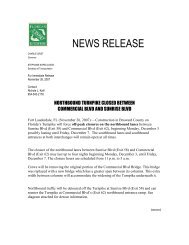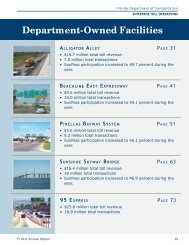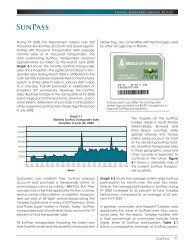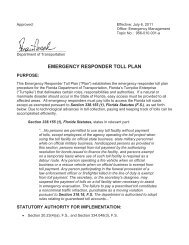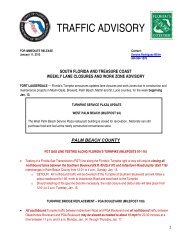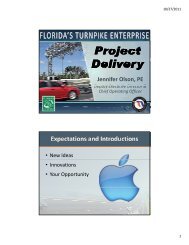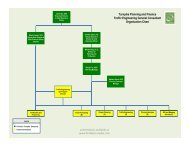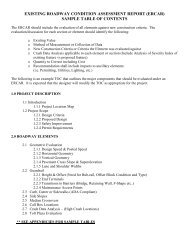Master Plan Update - Florida's Turnpike
Master Plan Update - Florida's Turnpike
Master Plan Update - Florida's Turnpike
Create successful ePaper yourself
Turn your PDF publications into a flip-book with our unique Google optimized e-Paper software.
2<br />
MASTER PLAN ANNUAL UPDATE<br />
3.0 development of the turnpike<br />
master plan<br />
the turnpike master <strong>Plan</strong> is an annually updated<br />
report that identifies all projects that are funded<br />
through the construction phase and are<br />
programmed and planned in the ten-Year finance<br />
<strong>Plan</strong>. It also contains a list of unfunded needs<br />
Projects.<br />
3.1 Project IdentIfIcatIon<br />
The identification of new projects to be included<br />
in the annual update of the turnpike master <strong>Plan</strong><br />
is made through internal and external means.<br />
Internally, the turnpike utilizes its transportation<br />
planning resources and other departments to<br />
assist in the identification of needed projects. The<br />
primary planning resource available to the turnpike<br />
is the Annual Traffic Trends Report. This report<br />
documents an analysis of the forecasts of future<br />
traffic demand for all the facilities in the <strong>Turnpike</strong><br />
system. the forecasts are compared to roadway<br />
lane-capacity thresholds to estimate if and when<br />
facility improvements will be needed.<br />
In addition, the turnpike reviews aerial photography<br />
to monitor turnpike system performance,<br />
and conducts an annual field review called<br />
the “turnpike tour.” the turnpike tour is a<br />
comprehensive system review performed by key<br />
staff from the turnpike functional areas of planning,<br />
Using aerial photography to monitor System performance<br />
design, construction, operations, tolls, finance,<br />
and maintenance. the focus of this effort is to<br />
incorporate their perspectives on deficiencies in<br />
safety, preservation, capacity, and efficiency.<br />
the turnpike also receives requests and ideas<br />
for new projects from external sources including<br />
metropolitan <strong>Plan</strong>ning organizations (mPos),<br />
expressway authorities, elected/appointed officials,<br />
private developers, members of the general public,<br />
and other florida department of transportation<br />
(FDOT) Districts or the FDOT Central Office.<br />
the turnpike studies proposed projects to determine<br />
feasibility and ultimately considers the following four<br />
factors when making a recommendation regarding<br />
whether a project should be implemented: (1)<br />
Project need; (2) Impacts to the environment; (3)<br />
local support; and (4) financial feasibility.<br />
Project evalUatIon crIterIa<br />
transportation<br />
need<br />
environmental<br />
soundness<br />
local<br />
support<br />
financial<br />
feasiBility<br />
Is there sufficient travel<br />
demand to justify the<br />
project?<br />
are there any major<br />
environmental issues that<br />
would impact and/or fatally<br />
flaw the implementation<br />
of the proposed project?<br />
Is there demonstrated local<br />
support for the proposed<br />
project?<br />
to what extent will the<br />
project's forecasted toll<br />
revenues contribute to<br />
funding this improvement?<br />
Projects identified for implementation have the<br />
ultimate goal of being fully funded through the<br />
construction phase in the turnpike adopted five-<br />
Year Work Program. however, depending upon



